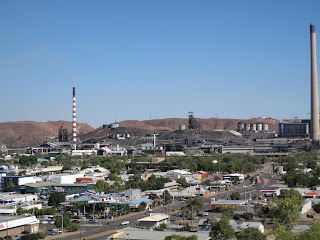Next morning (Monday 28th May) we hit the road again and did the loop around to Eromanga where significant dinosaur fossils have been found recently. Eromanga claims to be the Australian town which is furthest from the sea. As we couldn’t find any reference to the fossils in their Historical Museum – just pioneer history – plus the camp grounds were not appealing, we continued on to Quilpie for a dinner of spit-roasted pork and johnny cakes, followed by a live performance of country music. Fabulous! – even with the earplugs in.
Eric was in luck again the next night as the Charleville camp put on a roast lamb and apple pud dinner. We should have gone to the Cosmos Centre that night, but we booked for the following night when, you guessed it, cloud covered the sky and not one star was to be seen, so the event was cancelled. By this time I’d jacked up about eating any more camp-provided dinners, and even the exciting prospect of yabby races couldn’t entice me along.
During a prolonged drought in the early 20th century, a local meteorologist had the idea of using these vortex guns to fire at clouds in an effort to produce rain. No successes are recorded.
CHARLEVILLE – BARCALDINE
Pointing the rig north again, we made it to Blackall on the Barcoo River in time for lunch, on the way passing through pine plantations which eventually gave way to fine looking country with beautiful old trees lining the road. There was quite a bit of wildlife around – not all of it road kill - ‘roos, emus, dingoes, as well as the ferals.
Originally colonised by sheep and squatters following exploration by Major Mitchell, Blackall has a monument to the gun shearer Jack Howe whose world record of shearing (with blade shears) 321 sheep in under 8 hours still stands today. It also boasts the Australian Labor Federation Memorial which commemorates the formation of the first Shearers’ Union in December 1886, though we didn’t have time to visit this.
Pressing on to Barcaldine on the Alice River, we made camp just before a torrential downpour hit, which continued all night. It’s at times like this that we’re thankful that we have a hard top caravan, with heating and cooling, though recent nights have been a bit too humid for the electric blanket.
Next morning was grey and drizzly with a cool wind when we set out to view the sculptured memorial to the Tree of Knowledge. The main drag of Barcaldine is about a kilometre long, lined on the south side, opposite the railway line, with old pubs, about six all told. The town was full of caravans - caravans parked each side of the road and in all the camping spots, but then Barcaldine sits at the crossroads of north-south and east-west highways.
According to legend it was under the Tree of Knowledge that the shearers met during the Great Strike of 1891, which led to the formation of the ALP (and the Pastoralists Union). Someone poisoned the actual tree which has been preserved as the centrepiece of the monument, with recycled timber, representing the blades of shears, recreating the size of the tree canopy.
Next stop was the extensive (spread out over about an acre) Australian Workers Heritage Centre that commemorates the history of various types of workers.
BARCALDINE - LONGREACH
This morning we drove about 100k west of Barcaldine to Longreach on the Thomson River. We may have just got out in time as we’ve been told that Barcaldine copped another downpour. Drizzle accompanied us and the road had plenty of water over it and in the numerous potholes, as well as what seemed like corrugations. Corrugations on bitumen? Road trains, sometimes four trailers long barrelled past, while up ahead some caravans pottered along at about 75-80 kph. A challenging, though fortunately short, drive. Eric has got into the groove of towing and is now feeling very comfortable behind the wheel.
The dirt roads in the park are muddy, but probably won’t take long to dry out if the sun can make it through. I think more rain is predicted. It seems that sunny Queensland has turned into a permanently drenched state.
Tomorrow we’ll see what Longreach has to offer.



















.jpg)

.jpg)
.jpg)
.jpg)








.jpg)
